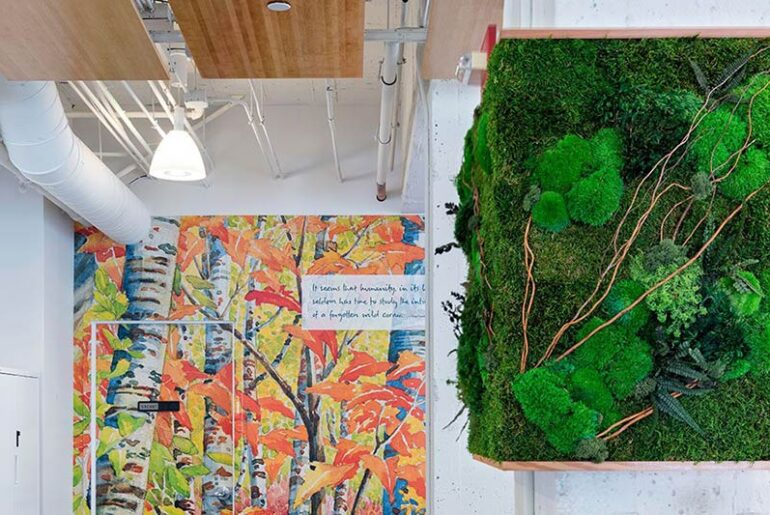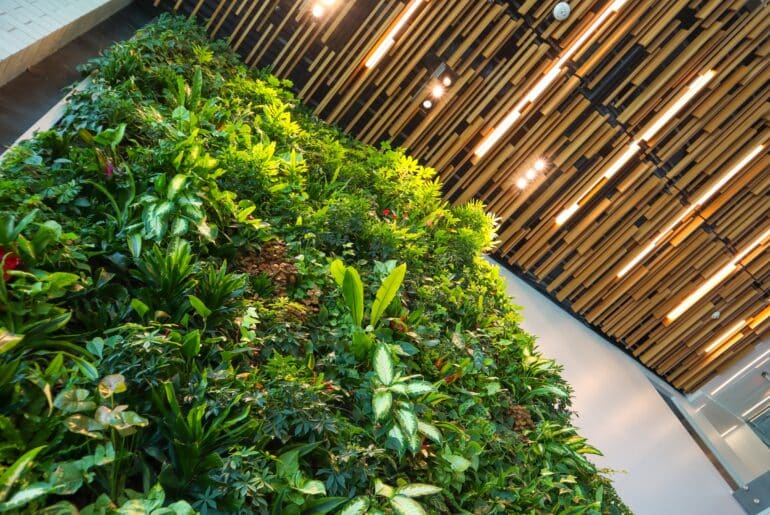Companies like Google, Microsoft, and Salesforce are leading the charge in biophilic design, partnering with research organizations to study the effects of biophilic design in their offices. Why?
With a rich evolutionary human history demonstrating the science behind biophilic design and humans’ innate affinity toward the natural world, as well as studies linking nature-based design to productivity outcomes including better sleep, increased job satisfaction, and greater creativity, robust research is beginning to prove that nature isn’t just good for you—it has a serious ROI.
Accordingly, the importance of biophilic design has been widely recognized by research-based green building frameworks and incorporated into standards such as LEED, Living Building Challenge, and WELL, providing clear paths for integrating biophilia into your building.
While the name itself suggests a focus on the design phase of building projects, it’s just as important for teams to consider how biophilic design will impact building operations—and vice versa—to have the greatest positive effects on occupants. Additionally, as a relatively new concept in the building world, biophilic design is often constrained to design discussions for new builds. However, there exists great opportunity to improve occupant health, focus, and mood through biophilic design in existing buildings as well.
Whatever stage your project is in, it’s not too late to make the most of nature-based design. Here are a few strategies to ensure biophilic design efforts are incorporated into operations and existing buildings as thoughtfully as they’re typically addressed during design.
BUT FIRST, CREATING A BIOPHILIC DESIGN STRATEGY
Biophilic design can incorporate just about every aspect of a building, from its form to its finishes to its daily operations. That’s why the International Living Future Institute’s Biophilic Design Guidebook recommends running stakeholder workshops throughout a project’s design phase in order to establish a personalized biophilic design framework that suits all parties involved.
Just like an ecosystem, biophilic design requires an integrated approach to building. At the end of this process, make sure to capture the project objectives and strategies in a comprehensive close out document or operations manual that can be referenced throughout the building lifecycle, no matter what framework your project team uses to guide biophilic design efforts.
IN OPERATIONS: GIVING FACILITY MANAGERS A SEAT AT THE TABLE
Unfortunately, most biophilic frameworks end here, at the design phase. But what happens to a biophilic building after it has been built? Who will care for the plants, maintain the water features, and implement feedback from building employees? It is critical to think beyond design and extend through the operation and occupancy of the building to make the most of its biophilic features.
A recent client experience highlighted the importance of working with facility managers when designing biophilic spaces. The architect had proposed a beautiful natural wall feature but hadn’t fully considered the way the feature would wear over time and how users might damage it. Based on their experience with similar non-biophilic features, the facility manager proposed a variety of changes that would make the feature longer lasting and easier to maintain.
Where possible, facility managers should be at the table when making biophilic design decisions to ensure the vision endures throughout the building’s life cycle. Facility managers provide the best vantage point for when biophilic elements should be introduced, improved, or maintained. They provide invaluable input on predicted challenges, ongoing expenses, and long-term value of biophilic elements. Because biophilic design is a relatively young field, tracking the results of innovative strategies and making changes as needed will be important in ensuring their success.
IN EXISTING BUILDINGS: IT’S NEVER TOO LATE!
While the media tends to focus on grand visions of glass cloud forests and giant living walls, biophilic design doesn’t have to be expensive or ornate. In fact, it doesn’t have to be part of the design phase at all. While it’s easiest to implement integrated biophilic strategies at the start of a project, some of the most impactful changes can be easily implemented throughout operations. Here are just a few examples:
1. Add potted plants and flowers.
2. Re-configure spaces to maximize natural light and views to the outdoors.
3. Create small spaces of refuge isolated with sound-absorbing furniture or partitions.
4. Invest in a water feature.
5. Hire a local artist to create a mural.
6. Play gentle bird song in common areas.
7. Organize outings to local parks or conservatories.
Work directly with your facilities team or collaborate with your design team or a third party expert to incorporate some of these elements around your office if in an existing building.
For more inspiration, look through the International Living Future Institute’s biophilic design case studies that highlight some of the healthiest, highest performing biophilic buildings in the world today. Let’s design and operate our built environment, the place we spend 90% of our time, more like the natural spaces that make us happier, healthier, and more human. Reach out to the Stok team to talk more about all things biophilic design (and just plain ‘ol nature—we love that too).




